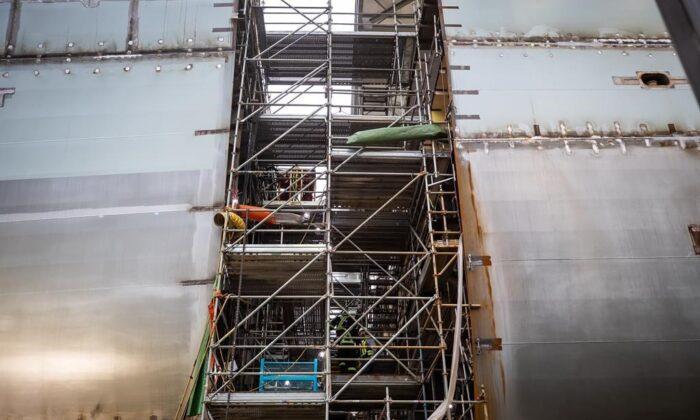OTTAWA—Federal auditor general Karen Hogan delivered a stark warning Thursday that government mismanagement is threatening to leave the navy and coast guard without the ships they need to defend Canada and protect its waterways.
The warning is contained in a new report tabled in the House of Commons that offers a scathing assessment of the state of Ottawa’s multibillion−dollar national shipbuilding strategy nearly 10 years after it was launched.
Hogan and her team found delays across the board in the construction and delivery of new ships for the Royal Canadian Navy and Canadian Coast Guard even before the COVID-19 pandemic began.
Those delays are threatening to create gaps as the navy and coast guard vessels that those ships are supposed to replace are near retirement, or in some cases have already reached that stage.
Those already retired include the Navy’s three destroyers and two support ships, while the Coast Guard has sometimes had to do without certain research vessels and icebreakers because the existing ships are docked for repairs.
Hogan’s report identifies a variety of problems and mistakes in the government’s management of the shipbuilding plan over the past decade, all of which have contributed to the problem.
She says the government has managed to mitigate some of the short−term effects, but she warns that Canada is already feeling the pinch as ships retire or are forced into extended maintenance with no replacements on deck.
“The delivery of many ships was significantly delayed, and further delays could result in several vessels being retired before new vessels are operational,” says Hogan’s report, which looked at how the plan was managed from January 2018 to January 2020.
“National Defence and the Canadian Coast Guard have implemented measures to maintain their operational capabilities until new ships are delivered, but interim capabilities are limited and cannot be extended indefinitely.”
The report added that it had not assessed the impact of the COVID−19 pandemic but noted that shipyards have either closed or reduced their workforces due to restrictions, which will further threaten schedules.
The auditor general’s report comes one day after the parliamentary budget office estimated that the construction of 15 new warships through the strategy will cost $77.3 billion, about $17 billion than the government’s stated price.
Both reports are likely to raise fresh questions about the shipbuilding plan, which was launched in earnest in October 2011 when Irving Shipbuilding in Halifax and Seaspan Marine in Vancouver were selected to build dozens of navy and coast guard vessels.
The government is now working to add a third shipyard to the program, Chantier Davie in Quebec City, to work on a series of icebreakers.
Hogan acknowledges the complexity of building new ships but says that was “compounded” by the shipbuilding plan’s other objectives: creating a Canadian shipbuilding industry, and boosting the economy.
Nearly a decade after it was launched, the auditor said the government did not know if the two shipyards in Halifax and Vancouver had even reached a state where they “met international ship−construction standards to enable efficient ship production.”
That was despite the agreements between the government and shipyards having “set the expectation that the (Vancouver) shipyard would achieve target state within about three years and the (Halifax) shipyard within about six years,” the report says.
“The level of target state achieved by the (Halifax) shipyard ... is expected to be assessed before February 2022.”
In fact, officials did not assess whether the shipyards—or even the government departments involved—had enough staff to implement the shipbuilding plan and deliver the new ships on schedule.
“We noted instances where such staff shortages caused shipbuilding delays,” the auditor’s report says, adding the government only drew up a draft human-resources plan for the shipbuilding strategy in December 2019.
“One of the early steps in the plan is to assess whether the government and industry have the capacity to carry out the strategy.”
Hogan’s report also catalogues some of the numerous changes to the schedule and cost of the various individual projects involved in the shipbuilding plan, which is supposed to deliver dozens of new vessels over a 30-year period.
That included several amendments to the contract with Seaspan Marine for three fisheries science vessels for the coast guard, which saw the delivery schedule pushed back by two to three years.
The report also revealed the Vancouver shipyard “sustained significant financial losses” during the construction of those vessels, the last of which was delivered last October, due to a significant underestimation in the time and effort needed to build them.
“This not only threatened the strategy’s overall objective of creating a sustainable marine industry,” the auditor general’s report says, “but also put the renewal of the federal fleet in peril.”
Hogan also raised concerns about the continued uncertainty around building a polar icebreaker to replace the CCGS Louis S. St-Laurent. The ship was pulled from Seaspan’s order book in 2019, but the government has not decided where it will be built.
The auditor general did suggest departments have started to learn from some of their earlier mistakes and expressed a cautious hope those lessons would ease some of the many problems afflicting the shipbuilding strategy.
“But there was little room for further delay,” Hogan’s report says. “Delaying could result in a loss of capability to deliver essential government programs.”
As an example, she noted that the last of the navy’s existing Halifax-class frigates is due to retire in 2047—only one year before the last of 15 new warships is scheduled to arrive.





